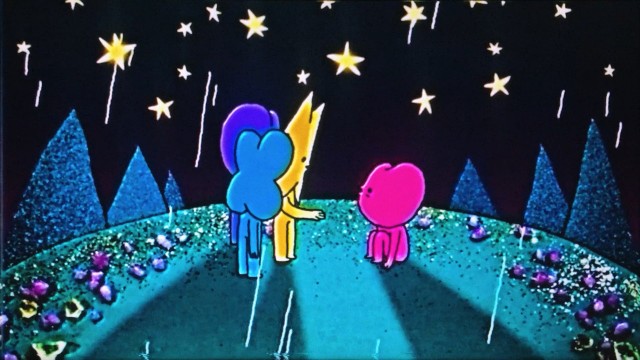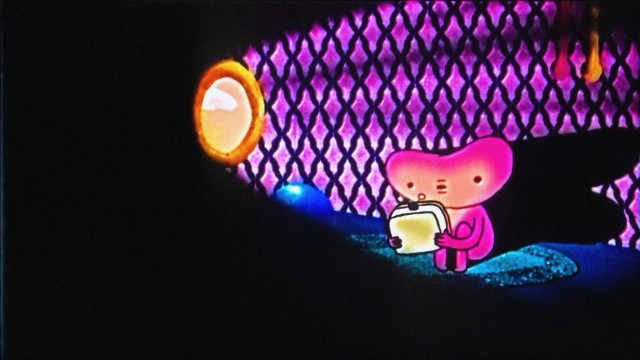If what you want out of a film review is to learn what a critic thinks about a work, I’m happy to clear that up top—I think The TOBOS is a masterpiece, the kind of conceptually brilliant, emotionally brave, and artistically assured work that exemplifies this site’s long time programming mission of “Head, Heart, and Hand” which graces our “submit a film” page. It’s rare to find a work that accomplishes each in equal measure and, as a random submission, the film invoked a giddiness in me upon first watch that all veteran programmers recognize when they sense a serendipitous but momentous discovery. Danish filmmaker Tobias Rud has made a “best of the year” contender. 4 stars, two thumbs up.
With that out of the way, the rest of this space can be dedicated to various musings as to why Rud’s 13min animation works, and what I find particularly interesting. It begins familiarly enough, as an homage to children’s television programming where we follow a Teletubbies-esque troupe of beings known as “TOBOS” inhabiting a fantasy land. The mixed media approach: paper cut-outs, digital 2D animation, and After Effects trickery combine to create, in Rud’s words, “a naive, one-dimensional and child-like world”. But, elements like deliberately poor compression and VHS-style distortion at the bottom of the screen self-consciously evoke a bygone era, making the film feel like a discovered artifact.
Referencing past children’s entertainment styles is almost always with an aim toward subversion. Short film does not do true all-ages content nearly enough, and when it does it is usually in search of original aesthetics. Therefore, as expected, the corny sweetness of the film’s inspirations is deliberately played against type in The TOBOS. Our lead (called “Bean-TOBO” due to the shape of his head) experiences the friendship and wonder of life and companionship in this magical world, yet something is off. When it is time to add something special to the friendship cake they do not have anything to give. Later, at home, they investigate this lack and a black ooze leaks out of their body. These events have an interesting presentation—the music fades in the mix and movements slow—the effect is to be hyper-attuned to Bean-TOBO’s perspective even as it feels like they are disassociating.
Something is wrong in fantasyland and at first, it is unclear whether it is external or internal to Bean-TOBO. What is clear is that Rud is subverting his “naive, child-like world”. But to what end? There are two usual paths—deconstruction and transgression, and The TOBOS embodies both approaches.
The film is a type of deconstruction of an idyllic fantasy of happiness and friendship, albeit as represented by a world where the sun has a face and tucks you in at night. What would it be like to take seriously the mental health of a Teletubbie? What does the viewer take away when trying to empathize with someone struggling in an environment of relentless positivity?

The simplistic vintage visuals contrast with more expressive scenes as the distinction between Bean-TOBOS’ perspective in times of connection versus disconnection are visually differentiated.
While provocative, I’d actually argue that this is not a particularly interesting aspect of the film. Treating fantastical premises “realistically” isn’t rare anymore, ever since the seeming entirety of professional media creation was bent towards fantasy, sci-fi, and comic book worlds that were once kids’ stuff. However, I’d argue that the alternate path, simple transgression misses the point too. This is the most popular mode of creation for artists evoking a children’s style, where they juxtapose the safe and familiar with vulgar content for shock value. Much of modern independent animation is built off this move, reacting against the culturally entrenched idea that animation as a medium is for kids. Despite decades of examples, this approach is still able to produce works we adore though, from the cultural pessimism of Steve Cutts to the viral shenanigans of the Don’t Hug Me I’m Scared crew to bring up two recent examples.
“I believe that we all just fundamentally want to feel connected to each other, but often for different reasons really struggle to do so.”
What is somewhat unsatisfying about this though is that vulgar (foul language, sexual content, extreme violence) becomes shorthand for “adult”, and it is The TOBOS departure from this association that begins to tease at what I find so remarkably fresh about the film. The TOBOS is transgressively “adult” but it is essentially good-hearted. The “adult” aspects are the actual content of adulthood: navigating our neuroses, dealing with inadequacy, relating to ourselves and others, messing up, and taking responsibility.
Rud was expansive with us in explaining the slippery concepts he was seeking to depict, noting that, “The film was inspired by a time in my life I was particularly occupied by feelings of connection and disconnection to those around me, and generally how different life can feel depending on which of those states you are in. I believe that we all just fundamentally want to feel connected to each other, but often for different reasons really struggle to do so.”
In light of this, we are able to decipher the essential move that Rud undertakes. The evocation of children’s entertainment is not to shock, nor is it to examine the unexplored psyche of a Teletubbie. It is in fact the inverse, to find the reference that best allows the articulation of the emotional feeling he seeks to describe. To be able to adequately depict disconnection, Rud must first establish connection. What does that look like? That seems hard! I struggle to picture how you’d go about that in live-action or animation that doesn’t instantly draw audience suspicion of phoniness or satire. The world of The TOBOS though is able to instantly trigger that association in an ingenious shorthand, and via the artifice of the vintage effects create a device that that both visually depicts the connection/disconnection binary, but also explains it, as an intermediary layer that is distancing and self-aware. The fact that such a landscape does not typically allow for the emotional introspection of the protagonist is transgressive, but in a way provokes narrative conflict rather than as a cathartic source of humor.
“I sometimes have this feeling that the world is such a lovely place SOMEWHERE,” Rud muses to us, continuing that, “…there is some level to life that if we can just enter that, being alive would be so lovely. But most often we are clouded by an ego- and fear-based noise of sorts, preventing us from being truly present and connecting with each other.” Rud is dealing with emotionally abstract themes, and yet the universality of the sentiment is undeniable, and with The TOBOS he has done as well as I’ve seen at communicating this deeply human truth. We are thrilled to present the film’s World Premiere after its recent completion out of Denmark’s famous The Open Workshop and are excited to see the path the film takes Tobias. I believe it to be a major statement from a now-major artist, and am curious to see if the world agrees!

 Jason Sondhi
Jason Sondhi
